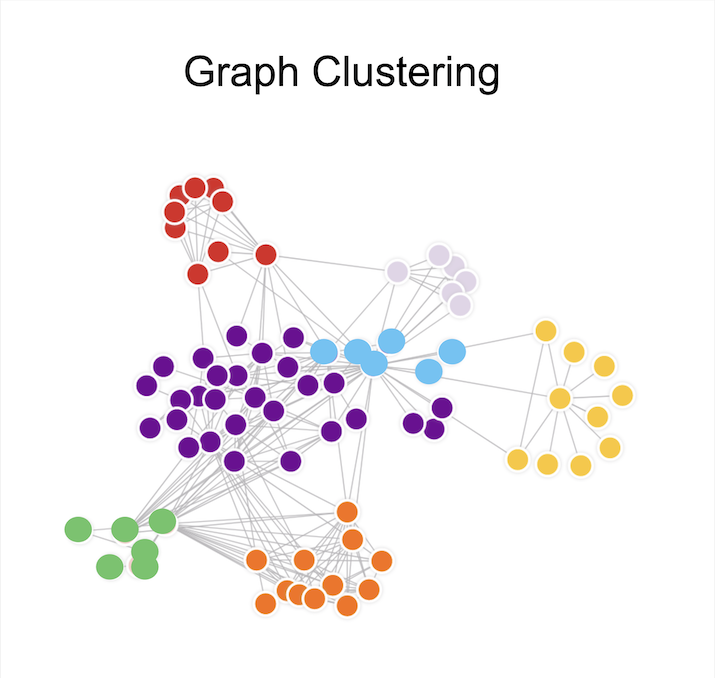
 Data Structure
Data Structure Networking
Networking RDBMS
RDBMS Operating System
Operating System Java
Java MS Excel
MS Excel iOS
iOS HTML
HTML CSS
CSS Android
Android Python
Python C Programming
C Programming C++
C++ C#
C# MongoDB
MongoDB MySQL
MySQL Javascript
Javascript PHP
PHP
- Selected Reading
- UPSC IAS Exams Notes
- Developer's Best Practices
- Questions and Answers
- Effective Resume Writing
- HR Interview Questions
- Computer Glossary
- Who is Who
Graph Clustering Methods in Data Mining
In data mining, the practice of grouping nodes within a graph based on their connections, resemblances, or other pertinent characteristics is known as graph clustering. It entails dividing the graph into clusters that are cohesive and have stronger intra?cluster connectivity than inter?cluster connectivity for their nodes. In many fields, including social network analysis, biology, web analysis, and recommendation systems, graph clustering is essential.
Graph clustering helps us to discover communities, find significant nodes, comprehend protein relationships, increase personalized suggestions, and uncover hidden patterns and structures inside complicated networks.
It enables improved decision?making and problem?solving in a variety of disciplines by offering insightful information on the connections and dependencies existing in interrelated data. In this post, we will be looking at graph clustering methods in data mining.
Understanding Graph Clustering
In order to identify significant patterns and structures in complicated data, a data mining approach called graph clustering groups nodes inside a network. From linked data structures like social networks, biological networks, and online graphs, it makes it possible to extract insightful information that is useful. Edges, which indicate connections or interactions between nodes, and nodes, which represent entities or data points, are the basic building blocks of graph clustering.
On the other hand, clusters are coherent groups of nodes that have more connections among themselves than they have with nodes outside the cluster. However, due to the enormous number of nodes and connections, the existence of noise and outliers, and the requirement to choose an acceptable clustering criterion, graph clustering poses difficulties and complications.
In order to obtain reliable clustering findings and improve comprehension and analysis of complicated data structures, it is essential to overcome these difficulties.

Popular Graph Clustering Methods
Spectral Clustering
A well?liked technique for identifying clusters in graphs is called spectral clustering. It uses the eigenvalues and eigenvectors of the Laplacian matrix of the graph. It extracts useful information from the spectral domain of the graph using spectral analysis methods from linear algebra.
The method entails computing the graph Laplacian, which encapsulates the connectedness of the network, and then breaking down the Laplacian matrix into eigenvectors. Spectral clustering can successfully find clusters in complicated datasets by grouping the data points based on the eigenvectors.
Spectral clustering has been successfully used in a variety of real?world applications, such as picture segmentation, document clustering, social network analysis, and gene expression analysis, where it has shown its capacity to identify complicated patterns and expose buried structures in the data.
Modularity?Based Clustering
A technique known as modularity?based clustering seeks to locate communities or clusters within a network by maximizing a parameter known as modularity. By comparing the density of connections within communities to the density of connections between communities, modularity measures how well a graph can be divided into communities.
The presence of clearly defined clusters is detected using modularity?based clustering algorithms, which iteratively seek the division that maximizes the modularity score.
The Louvain algorithm, which effectively finds high?modularity partitions through greedy optimization, and the Newman?Girvan algorithm, which uses edge betweenness to locate communities, are two well?known modularity?based techniques. These algorithms have successfully identified coherent groupings inside networks in a number of fields, including social network analysis and community detection.
Density?Based Clustering
A method called density?based clustering locates clusters based on the number of data points present in the feature space. Because it can accurately record the density fluctuations and node distributions inside a graph, it is highly suited for graph data
DBSCAN (Density?Based Spatial Clustering of Applications with Noise), a well?liked density?based clustering method, clusters together nodes that are strongly linked while isolating areas of lesser density. By focusing on edge density rather than point density, DBSCAN can be modified to find highly linked subgraphs in graph clustering.
Label Propagation
A semi?supervised approach to clustering graphs called "label propagation" uses the labels of a select few initial labeled nodes to infer labels for the remaining unlabeled nodes in the network. Using similarities between nodes and their neighbors as a starting point, the method iteratively propagates labels along the network. Nodes evaluate the labels of their neighboring nodes while updating their labels throughout each iteration, with the impact of near neighbors having a larger weight.
Label propagation is used in recommendation systems to provide suggestions for products based on the preferences of similar users and in social network research to discover groups based on shared interests or behavior patterns. Label propagation facilitates node clustering and the spread of important information throughout the network by utilizing the graph's connectedness.
Conclusion
We looked at the idea and importance of graph clustering in data mining in this blog article. We covered several techniques, highlighting their distinctive methodology and applications, such as spectral clustering, modularity?based clustering, densitybased clustering, and label propagation. The significance of assessment measures in determining the caliber of graph clustering outcomes was also emphasized. In general, graph clustering is extremely important for revealing hidden structures and patterns in complicated data, which enables insights and knowledge discovery in a variety of fields. These clustering approaches enable data analysts and researchers to extract useful information and make educated judgments by using the connectedness and linkages within graphs.

